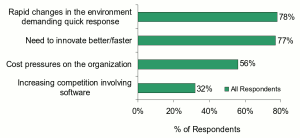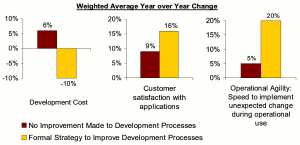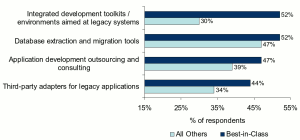
As the market recedes further and companies look to shed cost in any way feasible, many look inwardly in order to find key areas for improvement. Aberdeen’s research shows that the top business pressures forcing companies in the direction of legacy application modernization are largely internal (Figure 1).
The top two pressures have to do with agility. With the volatility of the current economy, opportunities for growth will be harder to come by, and organizations need to find ways to react to these opportunities before the window closes. Similarly, organizations are looking to become more internally agile as well.
In other words, tightening up the product development processes, being smarter about feature management, improving time-to-market are all reasons why companies are looking to drive more business value through legacy modernization.
Additionally, cost pressures to the organization factor heavily into this decision as the alternative — software development from scratch — is typically a more expensive endeavor than modernization.
In response to these pressures, the data shows that Best-in-Class companies are also adopting strategies that involve increasing the “agility” of the development process and of the resulting software, so that changes during both the development stage and the operational stage can be applied as swiftly as possible. The data shows that 59 percent of all respondents are taking steps to extend agile methodologies to new product development, innovation and R&D efforts as a top strategic action. In the case of legacy modernization, this may involve using SOA (service-oriented architecture) programming interfaces or modernizing user interfaces to use graphical presentation and a Web browser for delivery, or both.
The Business Value of Legacy Modernization
When it comes to a software development environment, companies essentially have three options to respond to market pressures. First, a company can stick with the status quo and not make any formal effort to improve development processes. Second, software modernization through migration, upgrade, or other means is a viable option. Lastly, an organization can pursue a “rip-and-replace” methodology wherein all new applications are developed from scratch — typically the most costly option.
Aberdeen’s research shows that companies who have embarked upon a formal strategy for legacy modernization are seeing demonstrable performance improvements over those sticking with the status quo (Figure 2).
The strategies that are in place for managing software process improvement are being used in new application development as well as in upgrading existing applications. The question that often faces users at this point is how best to achieve agility when an existing legacy application on the mainframe, AS/400/IBM i, OpenVMS/Unix or Windows client server platform incorporates much of the base functionality of the new one. More specifically, in such cases the IT strategist faces a choice between four tactics:
ol.thisol { font-weight:bold } ol.thisol span {font-weight:normal }
- Write from scratch: Discard the old application and write a new one.
- Migrate: Convert the application to run on a new platform, and in the process “improve” the application with an SOA-style Web-service provider interface or Web browser interface.
- Reengineer: Convert the application to an abstraction that can then generate either a more “modern” representation on the existing platform or multiple instantiations on multiple platforms — all supporting SOA/the Web.
- Upgrade in place: Front-end the application on its existing platform with a Web-service provider interface and/or Web-browser user interface.
A Best-in-Class Approach to Legacy Modernization
Whether brought on through acquisition or simply through organic growth, many organizations struggle to manage an IT infrastructure that is not only complex, but outdated. In a growing number of cases, the people equipped with the expertise required to manage these legacy systems have retired or moved on, leaving the organization shackled to a poorly understood quagmire of IT systems. In such situations, the cost required to maintain and drive value from a legacy infrastructure can become quite burdensome. Aberdeen’s prior benchmark report, “Modernizing Legacy Applications: Maximizing the Investment,” shows that Best-in-Class companies were largely taking a tools-based approach to legacy modernization and were leaning on the domain expertise residing in third-party organizations (Figure 3).
In addition to the technology enablers in use by Best-in-Class organizations, these top-performing companies were also more organizationally mature than all other companies across several areas. For instance, 61 percent of Best-in-Class companies report that their legacy applications and interfaces are well-defined and documented compared with only 43 percent of all other companies. Additionally, Best-in-Class companies were almost twice as likely as Laggards to have set aside budget specifically geared toward legacy modernization. By leveraging their organizational maturity in concert with a tools-based, third-party focused approach to legacy modernization, Best-in-Class companies realized substantial performance improvements. A few of these improvements are listed below.
- Forty-three percent of Best-in-Class companies saw a decrease in legacy integration costs, compared with only 9 percent of the Industry Average.
- Forty-three percent of Best-in-Class companies reported an increase in the number of new applications delivered that were based on legacy packages, compared with only 8 percent of Laggards.
- Sixty-one percent of Best-in-Class companies saw a decrease in the cost of legacy maintenance costs, compared with only 15 percent of all other companies.
Key Takeaways
The organizations enjoying Best-in-Class performance in legacy modernization shared a number of different characteristics that enabled them to achieve the type of performance that can drive long-term business value. From a high level, these companies shared two main attributes.
First, Best-in-Class companies have developed a level of organizational maturity around process, knowledge management, organization and performance measurement that positioned them well to implement the right modernization strategy for their organization. Second, the Best-in-Class also had a focus on utilizing the appropriate tools and consulting services in order to fill in the gaps in expertise and experience missing in their own organization.
The following recommendations serve as a guideline for any organization seeking to achieve Best-in-Class results in legacy modernization.
- Consider investing in third-party adapters and toolkits aimed at legacy systems. Given the multitude of legacy platforms residing in organizations, as well as the seemingly constant increase in IT complexity, many companies are finding it next to impossible to maintain a diverse portfolio of expertise to manage all these legacy systems. Perhaps more importantly, as the economy continues to recede, these companies are finding it cost-prohibitive to build and maintain this legacy experience.
Not only do many third-party service providers have wide ranging expertise, but in many cases they have already build tools specifically geared toward an array of legacy platforms. These tools can help facilitate a smoother modernization or migration process, ultimately leading to reduced IT costs. Aberdeen’s research shows that Best-in-Class companies are 73 percent more likely than all other companies to utilize these third party toolkits and adapters.
- Take steps to ensure that key developers, business analysts and architects are trained in the new technology. As the migration and modernization progresses, the need for aligning IT and business rests on the organization as a whole having familiarity with the new technologies. By training the key information workers and stakeholders on the new technology, companies will be better positioned to achieve this alignment. According to the research, Best-in-Class companies are 35 percent more likely than Laggards to have all their key stakeholders trained on the new technology.
- Create well-defined testing processes for legacy integration. At the outset of a modernization project, it is difficult to fully grasp the organizational impact of the modernization. Companies need to understand which applications are truly mission-critical and which don’t necessarily drive as much business value. By implementing concrete testing procedures, companies can better understand the effect of the legacy modernization and build a strategy that minimizes the impact to the organization and maximizes the original investment. The data shows that Best-in-Class companies are twice as likely as the Industry Average to have well-defined testing processes for legacy integration.
Michael Lock is a research analyst in business intelligence and information management for Aberdeen Group.















































